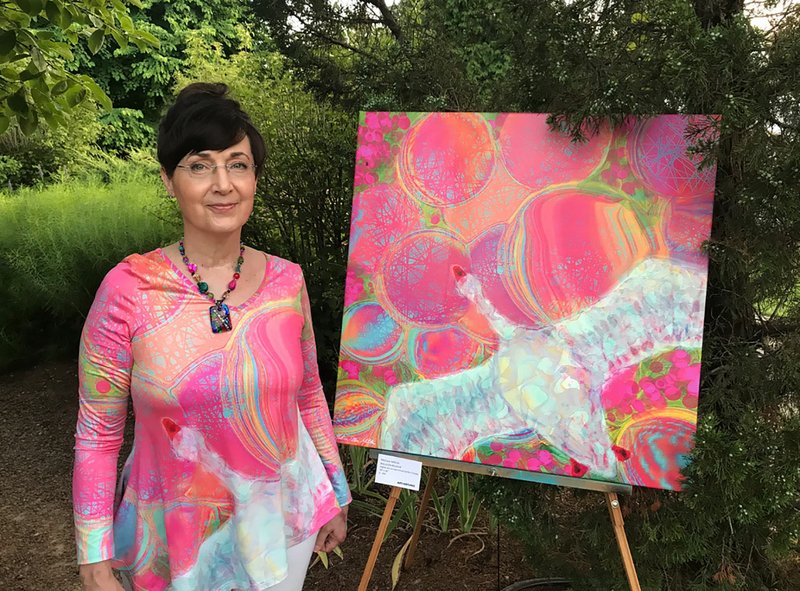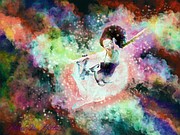On Sept. 5, during First Thursday in downtown Fayetteville, the Art Ventures gallery will debut its September exhibition "Personal Space" with an opening reception from 5 to 8 p.m. The exhibition features work by Buffalo, Kasey Hodges, Angela Davis Johnson, Melissa Milton, Dylan Mortimer, Erika Nelson, Tina Oppenheimer and Linda Vredeveld as they explore the theme of Personal Space.
Milton, like many creators, dabbled in art throughout her life before she came to it full time. Three years ago, Milton found herself physically disabled due to the progression of an autonomic nervous system disease called Dysautonomia. She is only able to stand for minutes at a time and even sitting upright is limited to a couple hours a day. After growing bored of television and reading, Milton turned to digital painting as a way to pass most of her waking hours lying down. The ability to draw and use a paint brush on a computer touchscreen was practical -- no spilled paint -- and allowed Milton to expound on her abilities in spite of her physical disability.
FAQ
‘Personal Space’
WHEN — on display Sept. 5-29; opening reception 5-8 p.m. Sept. 5
WHERE — Art Ventures, 101 W. Mountain Street, Fayetteville
COST — Free
Two years later, Milton is preparing for her third exhibition showing. Here, she answers a few questions for What's Up! about her work ahead of the opening at Art Ventures:
Q. How would you describe your work to a viewer?
A. I generally group my artwork into two groups. My first group of art is paintings. I have a natural tendency to paint in the vibrant colors which were popular in the décor, clothing and art popular during my childhood in the 1960s and my teenage years in the 1970s. I use multiple translucent layers in curved, relaxed flowing shapes which can potentially express an object in a new way which perhaps some people may have not seen before. I enjoy making the subject matter recognizable yet imaginative.
My second group of art is photographs I have taken and then later painted upon. Many of those photographs were taken by me underwater, because people often appear rather surreal underwater. You'll see three canvases of such painted underwater photo portraits in the show. I would describe one as looking as if a young girl were sitting on an ocean floor releasing a bouquet of flowers, a second one looks like a woman relaxing on a cloud in the moonlight, and the third looks like an underwater Mardi Gras celebrant.
Q. How do you feel your pieces reflect the exhibition's theme of "Personal Space"?
A. Speaking for myself, I can think of few things more personal to me than my artistic expression. A friend of mine who is a newer artist recently asked me what I thought she ought to paint. I immediately replied, "Paint WHAT you love and paint it HOW you love painting it." Because that's what I do. I paint what I love and I paint it how I love painting it, because that's what makes me happy. I guess it really can't get more personal than that.
Q. The exhibition description notes, "Some artists have unique challenges and use them as potent fuel to power their artistic creativity." Does this statement accurately describe your work?
A. My underwater photography came about because it is a peculiarity of people with Dysautonomia that we function almost normally when placed chest-deep in water. Our nervous systems are able to cope in an environment of such low gravity. So we have a therapy pool at home where I can stand for hours chest-deep in water ... despite only being able to stand for five minutes on land. The idea of taking underwater photos of people came to me one night when I was admiring the way the underwater pool lights danced on the dark walls in the room.
The therapy pool also influences my artistic style itself. I had painted about a dozen paintings before starting the underwater photographs. One day we decided to arrange them in a group on the dining room wall. My husband was the one who spotted it first. He said, "Boy, you sure can tell you spend a lot of time in water. Almost everything you paint glides around, swimming, flying or floating." I had not noticed that until he pointed it out. It is mostly fish, birds and even the people are usually floating or gliding around in some way. Even when the painting is of a stationary object such as a tree, the lines themselves are fluid like water.
There is currently no cure for my Dysautonomia, but I've hypothetically asked myself the interesting question, "Would I still create art if current research came up with medicine for it and I was suddenly able bodied again?" I honestly don't know the answer to that question. What matters is the circumstances we have before us, not what we might long for or wish that we had. So dealing in the right here, right now, I'm feeling very fortunate that I have an opportunity to spend every day creating my art.
NAN What's Up on 08/25/2019

